Mandaing, July 13, 2025.
One morning in May, a 45-year-old Daw Win Myint* was picking mangoes under a mango tree in their farmland. A young helper was plucking the mangoes for her. While picking mangoes, Win Myint looked up at a branch where several fruits were clustered together and pointed it out to the young man, showing him where to pick next.
At that moment, she suddenly felt a sharp pain above the ankle of her leg. When she looked down, she saw a burly Eastern Russell’s viper, over 1.5 feet long, with circular black spots on its brown body.
The snake bit her left ankle about five or six times. She fell to the ground and screamed, “Oh….my! I’ve just been bitten by a snake. Please help me!” As soon as almost all of the family members and the young man who was picking mangoes from the mango tree nearby heard Win Myint’s panicked cry for help, they quickly gathered around her.
At that moment, she was in a daze. Ma Thae Thae Zaw*, the niece of a snake-bite victim, told Mandaing Media that her aunt was completely unconscious after being bitten by a snake several times, and was shocked by the size of the snake.
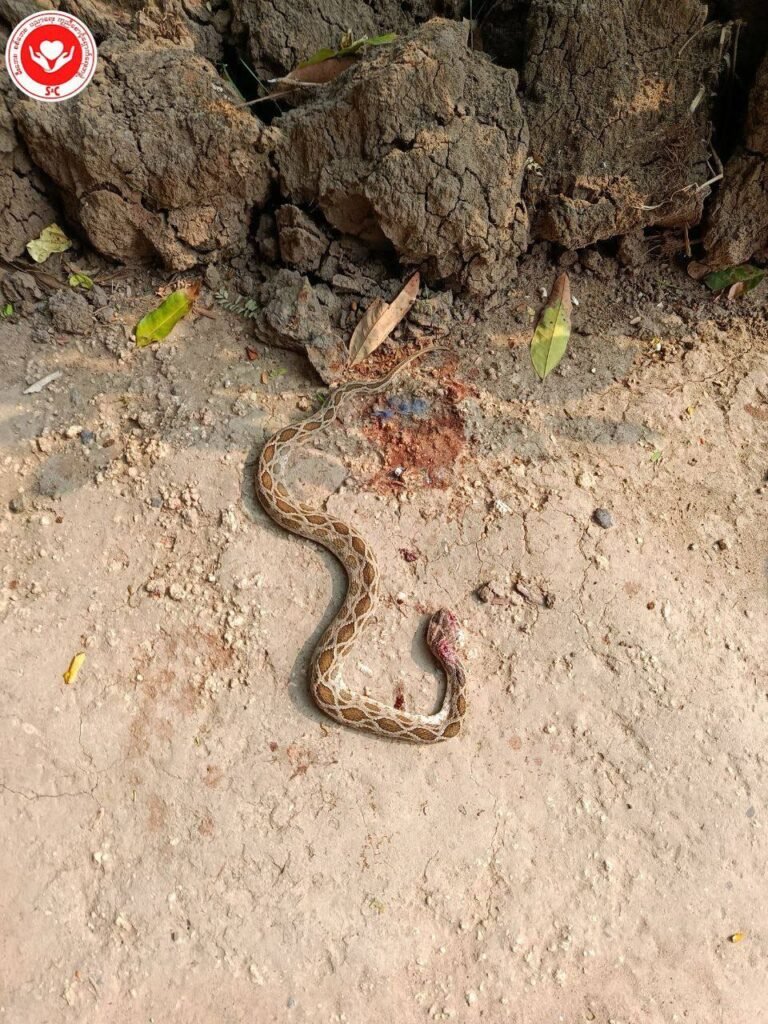
Win Myint and her family are from one of the large villages in Wetlet Township, Sagaing Region. After the airstrikes by the Military Junta on May 12 in Ohe Htein Twin village, in Depayin Township, they fled their homes to safer farmland with other displaced families, fearful of further air attacks.
On May 13 at approximately 7 a.m., while clearing debris and bushes in their farmland where the family was displaced, Win Myint encountered a snake. Due to its dangerous nature, they killed the snake.
She was bitten by a snake while picking mangoes under a large mango tree not far from her farm, having finished cleaning at around 8 am that morning.
Residents in the conflict-affected areas in Upper Myanmar, suffering from the military council’s airstrikes, say they are now afraid of not only the airstrikes but also the snake-bikes that have become more numerous on the ground, especially after the recent powerful earthquakes on March 28.
Ko Soe Moe Aung, head of the S & C Fire and Conflict Assistance Group based in Sagaing Region, confirmed to the Mandaing that “After the earthquakes, these poisonous snakes have come out more in the displaced areas. That’s why snakebites have increased.”
The S&C clinic records show that, on average, about four snakebite patients visited clinics monthly before the major earthquakes. However, this number doubled to about eight patients per month after the earthquakes.
S&C is a ground-based organization that provides housing, consumer goods, clothing, food (including rice and oil), snake venom antivenom, and healthcare services to displaced people in the Sagaing and Mandalay Regions.
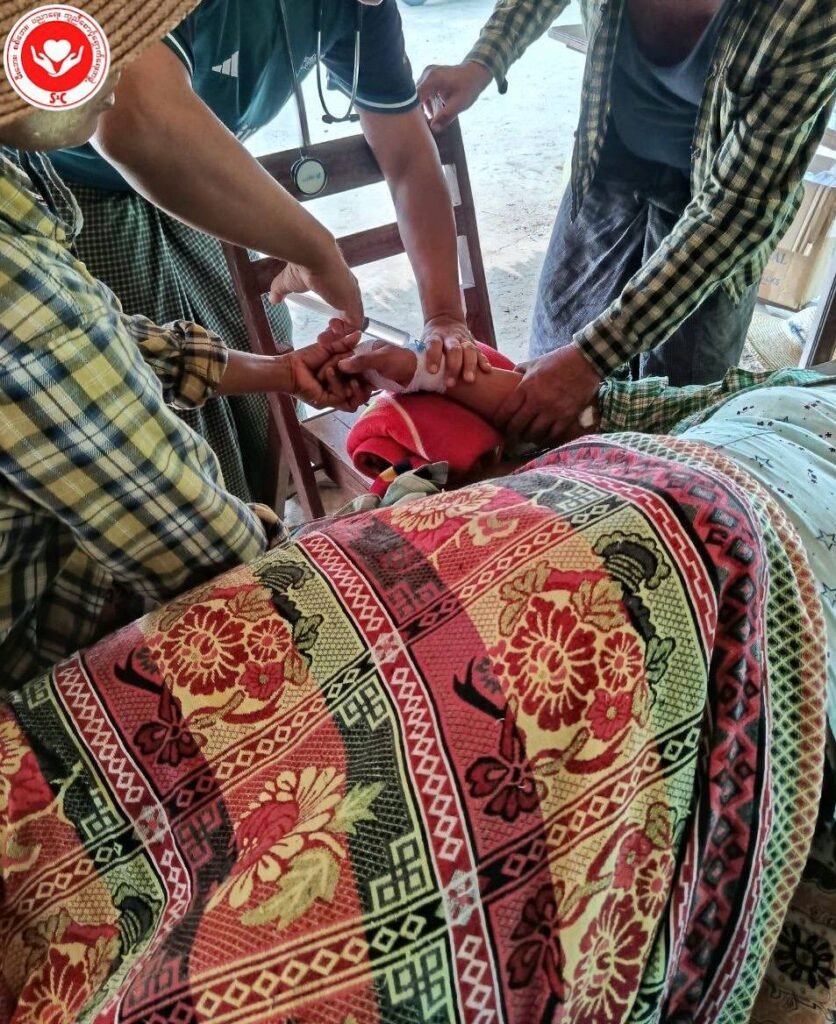
Ma Shwe Lei, well-known as the “Snake Princess,” who assists rescue efforts in Mandalay and Sagaing after the earthquakes, said, “When earthquakes occur, their (snakes’) nests like burrows and caves are collapsed and destroyed, and snakes are also affected. They also tend to move their nests and relocate, so people need to be careful.”
She is a volunteer rescuer and head of the Shwe Metta Rescue and Social Assistance Association based in Shwe Pyi Thar Township, Yangon Region. She and her team safely capture and relocate snakes from residential areas when residents request assistance, releasing them into natural habitats.
Snakes’ Sensitivity to Earthquakes and Early Warning Potential
International research papers have documented that snakes and other burrowing animals often leave their habitats, such as burrows and caves, before and during earthquakes.
Jiang Weisong, director of the Earthquake Bureau in Nanning, capital of the Guangxi autonomous region in Southern China, made a statement to Chinese state media on August 9, 2007, that China had developed an earthquake prediction system which relies on the behaviour of snakes. This announcement came two days after two consecutive earthquakes struck neighbouring Taiwan, according to Reuters, an international media outlet.”
“Of all the creatures on Earth, snakes are perhaps the most sensitive to earthquakes,” bureau director Jiang said. “Snakes could sense an earthquake from 120 km (74 miles) away, three to five days before it happens. They respond by behaving strangely.
Myanmar’s snake researcher, Ma Soe Thandar Aung, has analysed that after earthquakes, snakes and other burrowing animals emerge more frequently onto the surface when the ground cracks due to the earth tremors.
“Snakes will come out when the ground shakes and find another place to hide. The only places they can hide are houses that have been damaged by the earthquake and houses that have collapsed due to the earthquake,” she said.
“Therefore, after an earthquake, people should be especially vigilant about snake dangers, Soe Thandar Aung warned.
She is the administrator of the Facebook group “Snake of Myanmar (SOM),” which educates the public about snake awareness.
SOM is sharing knowledge on identifying snake species and varieties that people from all over Myanmar ask about. Experts and medical doctors from the group also answer questions about snake species and varieties correctly, explain how to protect oneself from snake bites, how to avoid poisonous snakes, and how to prevent conflicts between snakes and people.”
Additionally, the Native Species Conservation & Identification (NSCI), founded by Ko Win Paing Oo, collaborates with volunteer rescue groups to provide food, money, medicine, and building materials to earthquake-affected communities, while educating them about snake safety.
He noted a slight increase in snakes appearing above ground in Mandalay and Sagaing after the powerful earthquakes on March 28.
“We might think that it’s because more people in our group post incidents of snake sightings near where they live,” Win Paing Oo said.
NSCI has been distributing snake awareness campaigns to the public since March 29, after the powerful earthquakes in Sagaing and Mandalay on March 28.
Together with partner rescue organizations, NSCI confirmed to the Mandaing that approximately 50 snake capture incidents occurred in Mandalay and Sagaing cities in the two weeks following the earthquakes.
“Many other groups also assist with snake capture, so the real number might be higher. This is just an estimate. There may be other groups which assist with snake captures that we don’t have access to,” Win Paing Oo said.
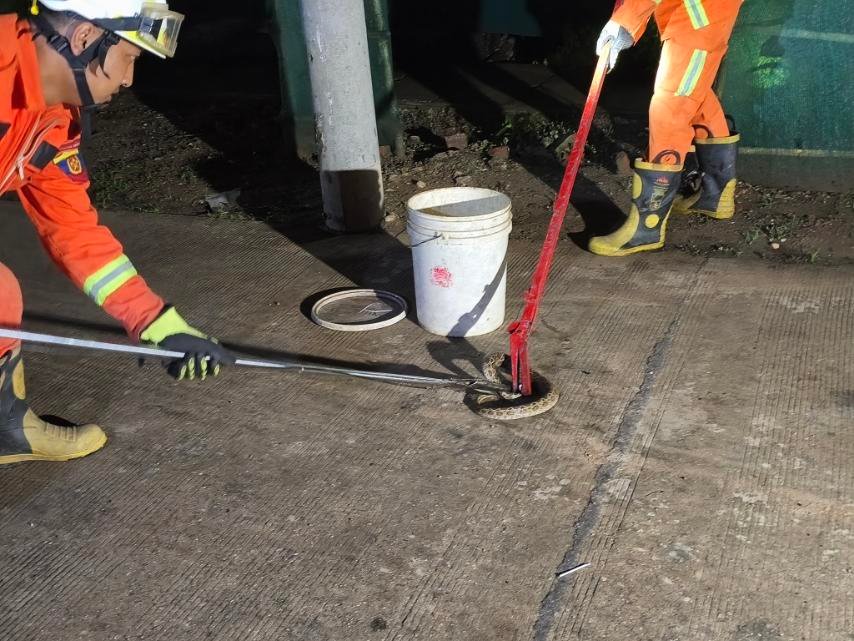
However, Mandaing attempted to contact Mandalay General Hospital and Sagaing General Hospital, which are under the administration of the military council’s health ministry, to inquire about the status of snakebite patients after the powerful earthquake, but the officials did not respond. Therefore, we have not received confirmation from the military council whether the number of snakebites has increased after the earthquake.
Snakebites: Trouble upon trouble
On March 28th, a powerful 7.7 magnitude earthquake struck near Mandalay and Sagaing, intensely shaking the region. While the main quake was devastating, aftershocks measuring 5.0 and above have continued to ripple across the country, keeping residents in a state of ongoing anxiety.
In particular, the earthquake-affected people in Mandalay and Sagaing Cities, which were particularly hard hit by the earthquake, are living in temporary relief camps arranged by the military council’s administrative groups, while most of them are living in vacant lots in front of their homes due to the delay and inefficiency of the relevant city governments in clearing the buildings that collapsed due to the earthquake. Therefore, the locals living in Mandalay and Sagaing are worried about the danger of snakes.
A 25-year-old resident of Mandalay City, Ma Nyein Chan Thu*, said, “After such strong earthquakes, I don’t dare to go back to my house. I often sleep on the open ground in front of my house. I’m worried that snakes will come out of their holes and I’ll get bitten.”
She lamented that worrying like this is “two pots on top of one pot” (Myanmar Proverb), meaning “trouble upon trouble.”
An official, who requested anonymity for security reasons and supervised management camps in Amarapura Township, Mandalay Region, for earthquake-affected people, confirmed to the Mandaing that a child was bitten by a snake at the ‘Aung Chan Thar’ relief camp in early April, and a young man was bitten by a snake at the ‘Thar Li Swa’ relief camp after Myanmar Water Festival, ‘Thingyan’.
Fortunately, these were bites from non-venomous snakes such as Ptyas mucosa, commonly known as the oriental rat snake, and both patients recovered.
“Most camps are set up in fields for convenience, which increases snake encounters,” the official said. “Therefore, we are planning to install streetlights in the relief camps so that people can walk with light at night.”
Snake Princess Shwe Lei warned that collapsed buildings from strong earthquakes inadvertently create havens for snakes in cracks and hollows. This is because these new cracks and hollows in the ground become perfect hunting grounds as rats, their prey, also seek shelter there.
The danger of snakes isn’t confined to residents in urban temporary shelters; even those in their own homes are unexpectedly falling victim to snakebites after the severe earthquake.
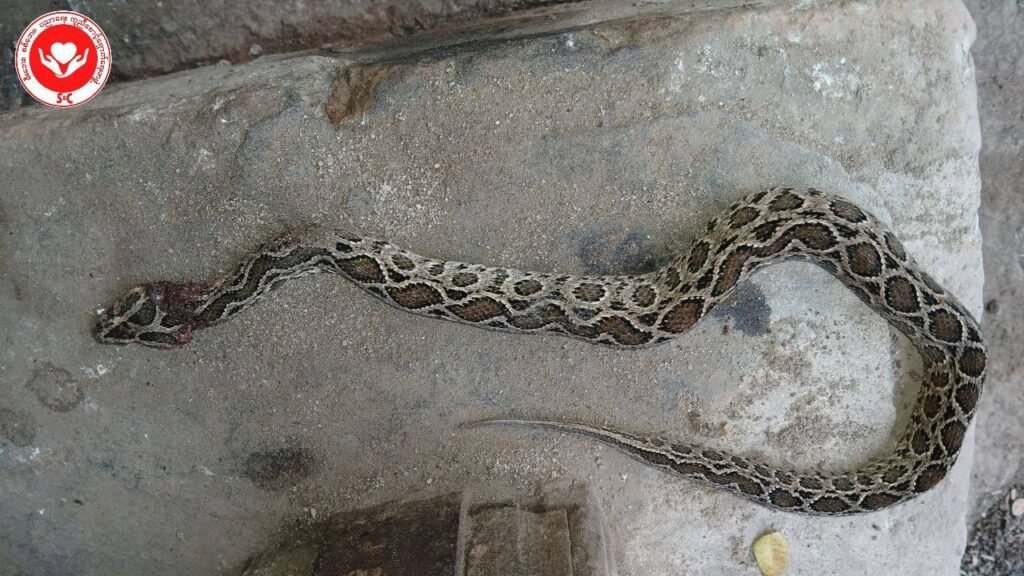
On May 8th, around 10 a.m., Ko Thura Htet*, a 29-year-old resident of Pakokku City’s Ward No. 14 in Magwe Region, was bitten by an unknown snake. The incident occurred as he entered his bedroom from the downstairs living room.
When Thura Htet immediately shook his leg, the snake quickly fled, preventing him from identifying or catching it.
Approximately 20 minutes after the bite, he arrived at Pakokku General Hospital. Unable to identify the snake, he remained hospitalized for a day to be monitored. Nurses performed blood and urine tests to monitor his condition.
With no signs of envenomation, doctors diagnosed the bite as non-venomous, discharging him in the afternoon on May 9th. However, Thura Htet observed a concerning trend: he saw three other male patients admitted for similar snakebites during his hospital stay.
Among the victims, a 50-year-old man, believed to have been bitten by a cobra on the night of May 8, was in the most critical condition. He had been sleeping on a mat on the ground outside his house due to the oppressive heat when a venomous snake bit his right forearm.
His entire hand, where the snake had struck, throbbed excruciatingly, and the victim, overcome by the venom, found himself unable to open his eyes. He also experienced intermittent bouts of vomiting. Thura Htet said that the patient fortunately recovered after receiving antivenom.
According to earthquake victims, healthcare volunteers, and voluntary rescue and social service groups in Sagaing and Mandalay, interviewed by the Mandaing, there are no issues with the supply of snake antivenoms in the District and Township-level Government Hospitals of the Ministry of Health in major cities under the control of the military council.
When treating snakebite patients, hospitals operating under the military council utilise two types of antivenoms: one for cobras and another for Eastern Russell’s vipers. Both are manufactured by the Burma Pharmaceutical Industries (BPI) factory in Yangon’s Insein Township, which the regime’s Ministry of Industry runs. These crucial drugs, however, remain difficult to purchase from private pharmacies.
The Critical Shortage of Antivenom for Displaced Communities in Upper Myanmar’s Conflict Zones
The military council has strictly blocked the export of food, medicine, fuel, and electrical appliances to areas controlled by the People’s Defence Forces (PDF) in Upper Myanmar, such as Sagaing and Magway regions.
Consequently, it is difficult for internally displaced persons (IDPs) in PDF-controlled areas to access antivenom and other essential medicines should they suffer a snakebite.
The most commonly used snake venom antivenom in Upper Myanmar is manufactured in India. This antivenom can be used for bites from both Eastern Russell’s vipers and cobras, according to Soe Moe Aung, head of the S & C group.
Two types of snake venom antivenoms are used in Myanmar: those manufactured by Myanmar Pharmaceutical Industries (BPI) and those from India. An antivenom vial costs over MMK 100,000 (approximately USD 23), based on an exchange rate of 1 USD = MMK 4390.
“We have to use antivenoms from India. We cannot buy BPI antivenoms in the country,” Soe Moe Aung said.
He further explained that although an antivenom vial from India typically costs about MMK 60,000 (USD 14) in its country of origin, the price can surge to MMK 150,000 (USD 34) in Sagaing, a consequence of transportation challenges.
“Even then, it’s not always possible to buy when needed,” Soe Moe Aung told Mandaing.
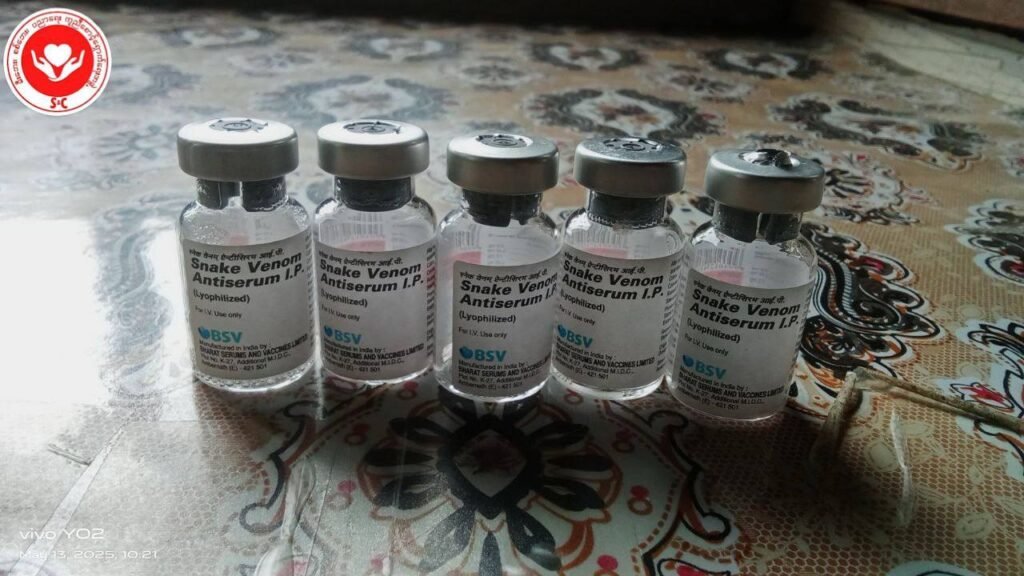
The most common venomous snakes causing bites in conflict zones are Eastern Russell’s vipers and cobras, with Shwebo and Depayin townships reporting the highest numbers of cases.
From June 19, 2023, to the end of this June, the S & C group’s free clinic has treated a total of 96 snakebite patients with antivenom. Although the S & C group did not officially announce death records due to snakebites, Soe Moe Aung confirmed that three deaths were a result of delayed treatment and severe envenomation.
According to the S & C group’s records, funding for antivenom and medical supplies primarily comes from domestic and international donors and NGOs. The National Unity Government (NUG) has not provided support yet.
Soe Moe Aung expressed their dire situation: “We have run out of antivenom.”
He said that the primary difficulties were his group’s lack of a budget to purchase medicine and the delayed arrival of medicine due to transportation challenges.
Many displaced people in Sagaing avoid travelling to government hospitals controlled by the military due to security concerns, as they must pass through numerous checkpoints.
Daw Thu Zar*, a displaced woman in Wetlet Township, said, “Because of the armed conflict, it’s not easy to travel quickly to hospitals, even in emergencies.”
In May last year, a 29-year-old displaced man from his village was bitten by a Russell’s viper while cutting firewood in the forest. His family attempted to transport him by motorbike to Sagaing General Hospital, but delays at checkpoints meant the patient died en route.
Dr. Thidar Pyae*, a public health expert and Lecturer in the School of Health Department at Spring University Myanmar (SUM), emphasised the importance of awareness regarding snake risks, especially after earthquakes, and urged victims to seek immediate medical treatment.
Spring University Myanmar (SUM) was established in May 2021 with the dual mission of supporting the interim education of youth and fundraising for at-risk scholars and vulnerable communities amidst the ongoing crisis.
“Delaying treatment can worsen the patient’s health condition. Proper first aid and timely antivenom administration are critical,” warned Dr. Thidar Pyae.
She also urged the public to take a snakebite patient to the hospital within one to two hours after the bite.
The “Golden Hour” for snakebite treatment is within one hour after the bite, according to international health organizations.
“Administering antivenom is most beneficial during this critical time,” Thidar Pyae told Mandaing.
Escalating Health Crisis: The Burden of Snakebite Envenoming in Future Conflict Zones
The military regime is carrying out daily airstrikes and bombings on ethnic armed groups and areas controlled by the People’s Defence Forces, and has also blocked the transportation of urgently needed medicines to these areas. Groups assisting the displaced people believe that the snake threat could lead to problems with snake venom antivenom in the coming years.
“Because of bombings and airstrikes by the military, displaced people run into the forest. When they run into the forest, they can see poisonous animals. Also, since it is the rainy season, snakes come out a lot during the rainy season,” said Soe Moe Aung of the S & C group.
Dr. Thidar Pyae urged that it is important to reduce the risk of snakes, so it is necessary to educate displaced people about snake safety and provide medical resources, medicines, and medical supplies for emergencies.
“Many locals are unaware of the dangers of snakes or how to react if bitten, which can lead to increased fear and even death,” she warned.
Snakebite victim Win Myint and her family have been displaced for over two years due to conflict and continue to face snakebite risks.
When her aunt was bitten by a snake while fleeing the war due to the military council’s airstrikes, Thae Thae Zaw tried to apply first aid to prevent the snake venom from spreading.
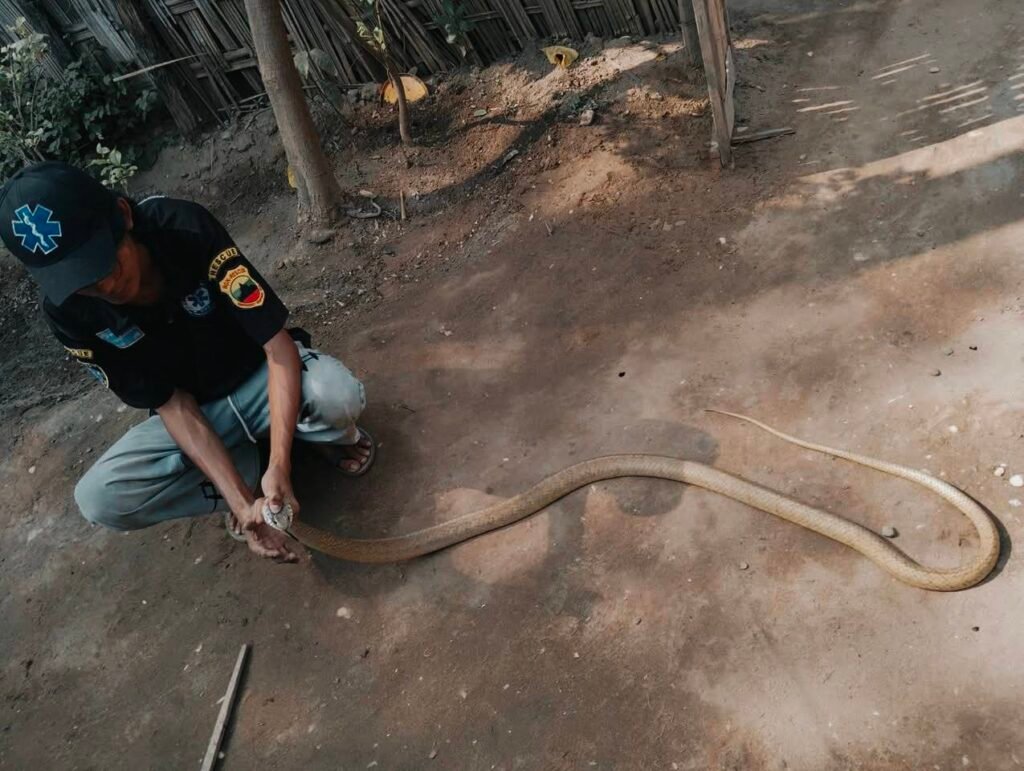
She loaded her aunt onto a cow-cart and went to the clinic in her village, and the snakebite patient arrived at the clinic. Luckily, the village clinic had some antivenoms
supported by S & C group, so she was able to administer 5 antivenoms made in India as soon as she arrived at the clinic.
However, because the snake venom is so severe, health workers estimate that Daw Win Myint will need 24 doses of antivenom.
These 5 antivenoms for Win Myint were donated by the S & C group. Healthcare workers from the clinic estimated that Daw Win Myint will need 24 antivenoms because the snake venom was so severe.
S & C group can provide a maximum of 5 free antivenoms to a snakebite victim. If a victim needs more antivenom, the victim’s family member can ask S & C for help. The group will provide the required amount of antivenom if they have enough. If the patient recovers, his/her family members have to buy the same amount of antivenom from S & C, according to Soe Moe Aung.
Win Myint’s family members managed to gather all 24 doses of antivenom and successfully administered them to her. However, due to the severity and number of snake bites she sustained, they were ultimately unable to save her life from the Lord of death.
Despite treatment, Win Myint passed away on May 14 at around 6:30 p.m. due to severe envenomation.
Dr. Thidar Pyae advised that if a person is bitten by a snake once, the amount of venom can be controlled, but if a person is bitten 3 to 6 times, the amount of venom in the body can increase significantly.
“As the number of bites increases, the need for antivenom treatment may also increase. The more bites, the greater the severity of symptoms and the greater the risk of complications,” she said.
Thae Thae Zaw’s uncle, U Kyi Win*, 58, was also bitten by an Eastern Russell’s viper on his left ankle while he was going to the paddy field on May 4. He is now living like a cripple at home due to the effects of the snake venom. He can no longer work in the fields.
Thae Thae Zaw, an IDP woman, lost her aunt due to a snake bite in May and is now taking care of her uncle, who was bitten by a snake while fleeing the war.
While fleeing the war, every IDP person in Upper Myanmar is wary of the airstrikes of the military in the sky and the dangers of snakes on the ground to save their lives.
Facing both airstrikes and snakebite threats, the IDPs are taking care of their own lives as best as they can protect.
“Nobody knows if we encounter dangers from venomous snakes or airstrikes in our native land, we all believe it is a matter of fate,” Thae Thae Zaw told Mandaing.
*Indicates the use of a pseudonym for security reasons

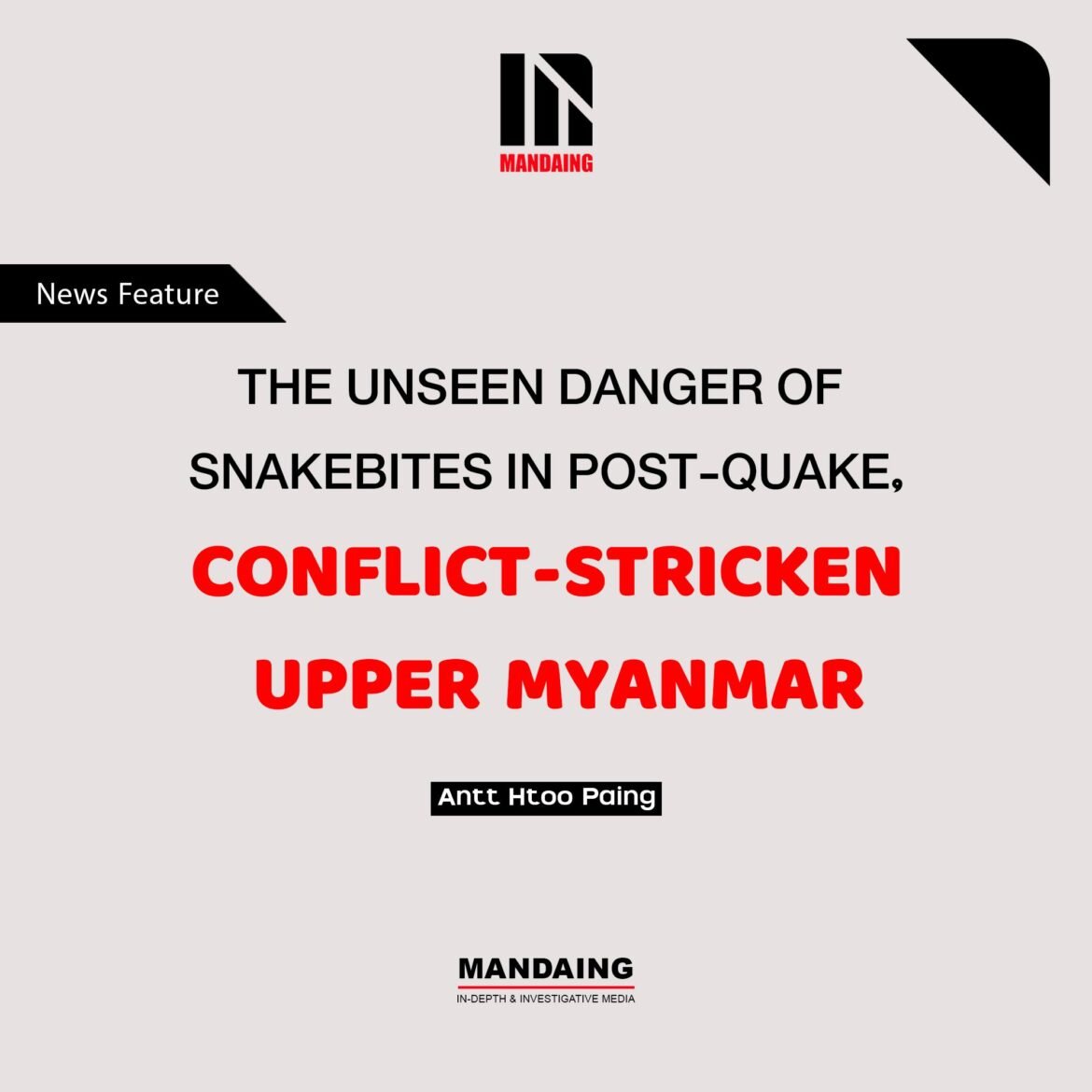

10 comments
Excellent breakdown of the topic. Really appreciate the detail!
https://t.me/s/Top_BestCasino/140
Hơn 1.000+ kèo cược thể thao tốt nhất thị trường sở hữu tỷ lệ thưởng cạnh tranh đang được 3 NPH Sportsbook cập nhật mỗi ngày tại nhà cái 66b. Bạn có thể thử sức với 40+ bộ môn khác nhau như: Bóng đá, bóng rổ, bóng chuyền, khúc côn cầu, Boxing, võ tổng hợp MMA,…
Về dịch vụ CSKH, 66b uy tín theo đuổi tôn chỉ “Ưu tiên trải nghiệm khách hàng”, từ đó đảm bảo mang tới cho bạn những giây phút giải trí có 1-0-2. Chuyên viên tư vấn tại nhà cái chúng tôi luôn được đào tạo bài bản, sẵn sàng phục vụ hội viên mọi lúc mọi nơi.
Nếu quá chán với kiểu cá cược truyền thống, anh em có thể đổi gió ngay sang sảnh chơi esport đỉnh cao mã nhận thưởng 888slot. Đây là xu hướng mới lạ, hứa hẹn mang tới phần thưởng hấp dẫn được đông đảo thành viên lựa chọn hiện nay.
188v game nổi tiếng với dịch vụ cá cược thể thao đa dạng, bao gồm các môn thể thao phổ biến như bóng đá, bóng rổ, tennis, đua ngựa và nhiều giải đấu lớn trên toàn cầu. Người chơi có thể tham gia đặt cược trực tiếp, với tỷ lệ cược luôn được cập nhật liên tục, đảm bảo sự minh bạch công bằng. Không chỉ vậy, nơi này còn cung cấp nhiều loại kèo khác nhau, từ kèo châu Âu, kèo châu Á, kèo tài xỉu cho đến kèo phạt góc, kèo hiệp phụ nhiều hình thức cược khác, đáp ứng đầy đủ nhu cầu của khách hàng.
77exgame looks interesting. Think I’ll create an account and check it out. Always on the lookout for new favorites!. Check it out 77exgame.
BJBaji88, what’s good? Giving this platform a thumbs up. Good selection of games and seem fair. Check it out bjbaji88.
Long777, never played there before, but the website name is very catchy! maybe it’s good for a long term entertainment. Worth a try if you are looking for something new. Find out more: long777
Nnbet4, here I come! Always up for a bit of a flutter. I’ll let you know if it’s a good one! nnbet4